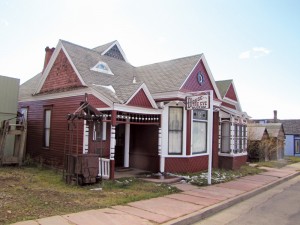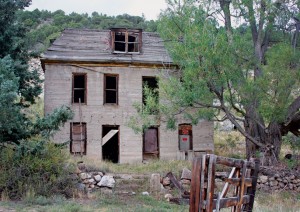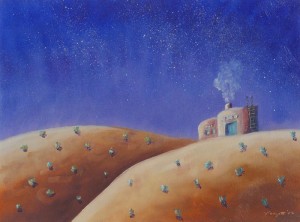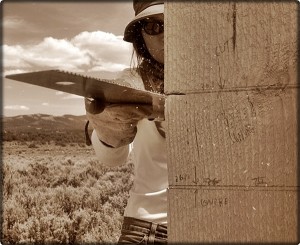By Lynda LaRocca. Photo by Stephen M. Voynick.
Leadville has long been called “the museum capital of Colorado.” And now another museum has joined the half-dozen already chronicling the history of the frontier West’s wildest, richest silver camp.
This one’s a resurrected museum, actually. And “resurrected” is an appropriate word for a place watched over by the Eye of God.
 Known for its roofline window fitted with a bright-blue, stained-glass eye representing the All-Seeing Eye of God, The House with the Eye was a museum for 23 years before closing in 1987 after the death of local newspaper reporter Mary B. Cassidy, who owned and operated it with her husband George.
Known for its roofline window fitted with a bright-blue, stained-glass eye representing the All-Seeing Eye of God, The House with the Eye was a museum for 23 years before closing in 1987 after the death of local newspaper reporter Mary B. Cassidy, who owned and operated it with her husband George.
Constructed in 1879 by Eugene Robitaille, a Canadian master carpenter and architect whose contracting business boomed in the wake of Leadville’s great silver strike of 1877, The House with the Eye was one of four buildings Robitaille erected on the same block of West 4th Street. When he and his wife moved next door the following year, Robitaille converted The House with the Eye into his company’s office and model home.
Contrary to legends, one of which claims that the eye was installed to put a curse on nearby State Street’s red-light district, the eye really illustrates a then-popular architectural convention of adding fancy or unusual stained-glass windows to otherwise plain home fronts. The deeply religious Robitaille simply chose a design that reflected his own piety.
After being shuttered for 24 years, The House with the Eye reopened in August, through the efforts of Mary Cassidy’s daughter Barbara Bost and Neil V. Reynolds.
A private-practice lawyer and municipal court judge for Leadville and Buena Vista (see “Presiding over the Highest Court in America: Neil V. Reynolds, A Man of Many Talents” in the September 1995 Colorado Central), Reynolds is, to put it mildly, fanatically committed to preserving Leadville’s past.
This fifth-generation Leadville native recalls working at The House with the Eye as a high-school student in the summer of 1968, when its visitors included actress Debbie Reynolds (no relation) who portrayed Leadville resident Margaret Tobin Brown, the title character of the 1964 film The Unsinkable Molly Brown.
The actress, accompanied by her parents and her 11-year-old daughter Carrie Fisher, who also became an actress, agreed to sign an autograph. “But I couldn’t find anything that would write in the entire place,” Reynolds laughingly recalls. “So I kept Debbie Reynolds waiting while I literally ran to the bank to borrow a pen.”
Reynolds, the driving force behind the nearby Tabor Home museum – an 1877 frame cottage built by flamboyant, scandal-plagued Leadville founder and silver baron H.A.W. Tabor for his first wife Augusta – had long envisioned the rebirth of The House with the Eye.
“So last spring, I called Barb [Bost] and said, ‘How about opening The House with the Eye?’ I figured she’d say, ‘No,’ but instead she said, ‘I’ll think about it.’”
Bost did more than think about it. She hired contractors to install new wiring and repair bulging walls, collapsed ceilings, and a caved-in fireplace in the nine-room, two-story home.
Reynolds, meanwhile, became – and remains – the museum’s “manager, operator, tour guide, and jack-of-all-trades.” He took on its interior decoration, arranging antique furnishings and accessories (none of which are original to the Robitailles, although all have been donated by Leadville families) and selecting color schemes for individual rooms, which are painted rich shades of blue, green, gold, and dusty rose. He also oversaw restoration of the original, hand-carved, pine woodwork.
The result is a charming residence that represents the pinnacle of working-class achievement in early Leadville.
Displays include a circa-1925 electric player piano; a Prohibition-era still; a “trench art” vase and candelabra made from World War I brass shell-casings; a high-topped, lace-up, black-leather shoe that belonged to “Baby Doe” Tabor, H.A.W. Tabor’s infamous second wife; a 1904 Edison’s Rotary Mimeograph machine, period clothing, vintage mining equipment and Reynolds’ personal favorite, a horse-drawn, circa-1890 hearse.
Located in the museum’s Carriage Room, this ornate hearse was known as the “light one” because its gray color meant it was reserved for the funerals of women and young people. A black hearse was used for men, while a small, white hearse pulled by a pony bore the remains of infants.
I am fascinated by a collection of nooses, especially one used at the public hanging of convicted murderer Si Minich in February 1886. Declaring his innocence to the bitter end, Minich told the crowd assembled to watch him die that he was “here through perjury and conspiracy.”
“Here” referred literally to a recently built gallows that “ … glistened like a new silver dollar when the sun shone upon it,” according to the Evening Chronicle – a gallows constructed by none other than Eugene Robitaille.
IF YOU GO …
The House with the Eye, 127 West 4th Street, is open for guided tours by appointment only until Memorial Day weekend when regular summer hours resume. Nominal admission fees. 719-486-0708.




